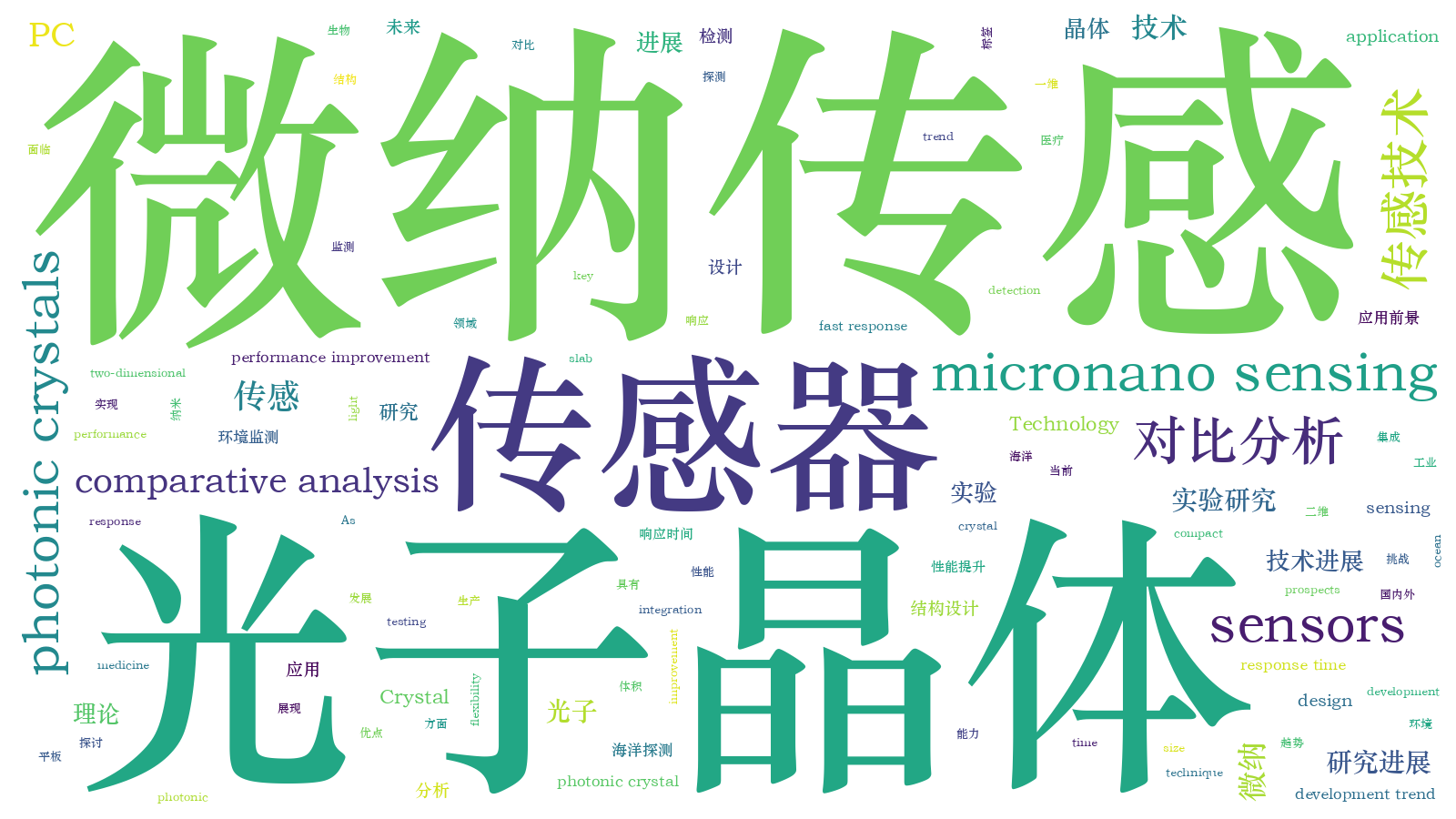光子晶体微纳传感技术的理论与实验研究进展  下载: 1802次特邀综述
下载: 1802次特邀综述
1 引言
随着科学技术的发展,人们对传感器性能的要求越来越高。1978年,普林斯顿大学的John等[1]和Bell通信研究室的Yablonovitc等[2]在研究材料中周期性电介质结构对光传播行为的影响时,几乎在同一时间分别提出了光子晶体(PC)的概念,提供了一种全新的控光机制。不同于以往利用全反射方式实现对光子的引导传输,PC通过周期性排列的电介质形成光子带隙,以实现对光子传输的引导和控制。PC由于具有体积小、控光能力强、设计灵活等优点,在传感领域引起了广泛关注,尤其在近几年,其研究重点从最初的基本原理和材料开发向芯片化和多功能化等方向逐渐转变。
PC微纳传感技术作为一种全新的传感器基础技术,与传统的传感技术相比,具有响应时间短、体积小、易集成、抗干扰能力强以及可实现无标签检测等优势。目前,国内外主要的PC传感器根据其应用领域可分为温度传感器、生物传感器、湿度传感器、化学传感器、气体传感器和压力传感器等,根据其结构特性主要可分为一维、二维、三维PC传感器等。本文聚焦于近年来研究较多的基于一维纳米束PC和二维平板PC的微纳传感器,从结构设计与传感性能提升的角度,综述了PC微纳传感关键技术的理论和实验研究进展,并探讨了其未来应用发展所面临的挑战。
2 一维纳米束PC传感关键技术及性能
一维纳米束PC是介电常数只在一个方向上呈周期性变化的PC,基于其所设计的光学微腔具有品质因子(
一维纳米束腔按光的局域位置,一般可分为介质模腔、空气模腔和槽腔,如
表 1. 提高纳米束腔Q值的实验研究
Table 1. Studies for improving Q factor value of nanobeam cavity
|
![典型一维PC纳米束腔的结构及场图。(a)介质模腔[8];(b)空气模腔[9];(c)槽结构腔[10]](/richHtml/gxxb/2018/38/3/0328003/img_1.jpg)
图 1. 典型一维PC纳米束腔的结构及场图。(a)介质模腔[8];(b)空气模腔[9];(c)槽结构腔[10]
Fig. 1. Schematics and electric field distributions of several typical 1D PC nanobeam cavities. (a) Dielectric-mode cavity[8]; (b) air-mode cavity[9]; (c) slot-based cavity[10]
2.1 基于介质模腔的一维纳米束PC传感技术
一维纳米束PC的介质模腔可将其光学模式主要局域在高折射率区域,易于获得高
一维纳米束PC介质模腔不仅控光能力强,在实际应用中设计也非常灵活,近几年一维纳米束PC介质模腔用于传感领域的典型结构及其传感特性见
表 2. 应用于传感领域的一维PC介质模纳米束腔
Table 2. 1D PC dielectric-mode nanobeam cavity applied in sensing field
|
2.2 基于空气模腔的一维纳米束PC传感技术
基于介质模的一维PC纳米束腔具有较强的光子局域能力,但其光场模式主要局域在高折射率的介质中,不利于光和低折射率区域中物质的反应,因此在一定程度上制约了灵敏度的提高。因此,为了进一步提高灵敏度,增强光与低折射率区域物质的反应,研究人员提出了一种基于空气模的一维纳米束PC微腔结构。空气模纳米束腔通过操纵能带的空气模带隙边缘,将中心腔孔的空气带隙边缘局域到波导两侧孔的PC带隙中,可使光场主要局域在低折射率区域,能带如
近几年一维纳米束PC空气模腔用于传感领域的结构及其传感特性见
表 3. 应用于传感领域的一维PC空气模纳米束腔
Table 3. 1D PC air-mode nanobeam cavity applied in sensing field
|
2.3 基于槽结构腔的一维纳米束PC传感技术
通过前文分析可知,通过增强光在低折射率介质中的能量分布以增强光物之间相互作用是提高传感器检测灵敏度的一种有效方法。相较于介质模腔和空气模腔,槽结构腔的谐振光场主要局域在槽波导中,光物的接触面积更大,光物反应更加充分,因此可进一步提高传感器的灵敏度。
近几年,一维纳米束PC槽结构腔在传感领域的应用及其结构和传感特性见
表 4. 应用于传感领域的一维PC槽结构纳米束腔
Table 4. 1D PC slot-based nanobeam cavity applied in sensing field
|
基于上述分析可知,将光场局域到低折射率区域中,可有效提高传感器的灵敏度。对大部分传感器而言,灵敏度越高越好,如何在此基础上进一步提高传感器的灵敏度,研究人员仍然在探索。对于基于PC结构的传感器,当前还没有非常有效的方法,根据目前为数不多的研究可知,PC表面模可能是一个重要方向,一维PC表面模缺陷腔在传感中的典型应用见
表 5. 应用于传感领域的一维PC表面模缺陷腔
Table 5. 1D PC surface-mode cavity applied in sensing field
|
3 二维平板PC传感关键技术及性能
二维PC是介电常数在二维空间呈周期性排列的结构,相对于一维PC,二维PC的结构设计更加灵活多样,能够依据需求而构造各种不同的高性能传感器,如折射率传感器、生化传感器、压力传感器等。典型的二维PC结构是由一些圆的或方的介质柱在空气背景中排列成六方晶系(三角晶格),或由空气孔在介质背景中规则排列而成的。在理论、实验研究及实际应用中,二维PC微腔传感器多以三角晶格空气孔型平板作为基础平台,相较于介质柱型的二维PC,其在横电(TE)模式下具有较大的光子带隙,并且对光子具有很强的局域效应,因此通过破坏二维PC的完美结构从而形成的各种缺陷微腔可用于高品质因子、高灵敏度及低探测极限的传感器检测。
近年研究较多的二维平板PC传感器按其结构设计的不同可分为点缺陷腔传感器、异质结构腔传感器、慢光波导传感器以及导模谐振传感器等。不同结构的传感器性能也有所不同。
3.1 基于点缺陷腔的二维平板PC传感技术
通过去除、增加或移动等方式改变二维PC结构中的完美周期性结构,可以构成点缺陷腔。点缺陷腔由于具有结构简单、体积小、易集成以及光场局域性能良好等优点,是二维平板PC微腔的一类重要结构,在PC传感器中的应用也较多。
设计高性能的二维平板PC点缺陷腔对其后续应用非常重要,类似于一维纳米束PC微腔,其设计理念和性能也分别经历了一个逐渐发展和不断优化的过程,典型的基于二维平板PC点缺陷腔的设计及其关键性能见
表 6. 高品质因子的二维平板PC点缺陷腔
Table 6. 2D slab PC point-defect cavity with high quality factor
|
与其他结构不同的是,该设计中PC平板平面内光场的强局域能力并非是由PC的禁带效应造成的,而是PC平板谐振腔模式与二阶导模之间弱耦合的结果。2011年,北京邮电大学的Yang等[36]仅仅通过移动空气孔的位置,首次提出并形成了H0微腔(即无需去除PC平板中空气孔,仅通过调整相邻空气孔的相对位置而形成的缺陷腔)模型,该模型的结构简单,对PC微腔的单片集成具有重要意义。2012年,美国的Chakravarty等[37]以L3腔为基础,通过去除PC平板同一方向上的
二维平板PC点缺陷腔具有简单的结构和良好的控光性能,在传感领域得到了学者们的广泛关注,近几年其在生化传感中的典型应用见
表 7. 应用于生化传感领域的二维PC点缺陷腔
Table 7. 2D PC point-defect cavity applied in biochemical sensing field
|
3.2 基于异质结构微腔的二维平板PC传感技术
异质结构是指整体或局部结构渐变的PC微腔结构。异质结构微腔可通过调节其结构参数,使谐振模电场分量的强度在空间上随距离的变化更加平缓,从而减小谐振模在漏模部分的光场分量,有效增强微腔对光场的局域能力[45]。2005年,日本京都大学的Song等[45]首次提出了一种晶格异构的PC微腔,通过优化其
3.3 基于慢光波导的二维平板PC传感技术
利用PC的慢光效应可以减小光在波导中传播的群速度,增大光场的能量密度,从而增大光与周围物质的相互作用强度,因此常被用于高灵敏度传感器的设计中。近几年,PC慢光波导在传感领域的典型应用见
表 8. 应用于传感领域的二维PC异质结构微腔
Table 8. 2D PC heterostructure cavity applied in sensing field
|
表 9. 应用于传感领域的二维PC慢光波导
Table 9. 2D PC slow-light waveguide applied in sensing field
|
3.4 基于导模谐振的二维平板PC传感技术
利用导模谐振设计微腔实现传感是二维平板PC的另一种应用。与PC平面内的谐振模式相比,导模谐振不仅可以将光从平板PC的平面内引导到周围环境中,从而增强光物之间的相互作用,而且易于激发出高的
0 应用于传感领域的导模谐振二维平板PC结构
0 2D slab PC structure with guided-mode resonance applied in sensing field
| Reference | Structure | Sensitivity /(nm·RIU-1) | Detection limit /RIU | Analyte | Research type | |
|---|---|---|---|---|---|---|
| [57] | 7.1761×104 | 902 | 10-6 | Liquid | Simulation | |
| [58] | 1.06×104 | >800 | 1.6×10-7 | Liquid | Experiment | |
| [59] | 5.5×103 | 298 | 1.3×10-6 | Liquid | Experiment | |
| [60] | 1.8×104 | 94.5 | 3×10-6 | Liquid | Experiment |
4 集成结构PC传感关键技术及性能
除了基于单一传感单元的一维纳米束PC传感器和二维平板PC传感器,基于多个传感单元集成结构的PC传感技术近年来也得到了快速发展。相较于单传感单元的传感器,多传感单元的传感器可实现更复杂的功能,如通过额外设置对比腔或通道以消除温度等环境噪声的干扰等;还可提高集成度,如可将多个传感单元与单个或多个硅波导或二维PC的W1波导进行耦合以复用等。复用的传感器在设计时需要考虑彼此间的相互影响,通常的处理方法主要有两种:一种是在空间上使不同的传感单元或区域的间隔足够大,如通过多路并联等;另一种是在频域上使各传感单元微腔的谐振波长在频谱上的间隔足够大,如通过滤波器滤除谐振腔中与传感无关的光波模式,或通过优化增大谐振模式的自由频谱范围(FSR)等。正是由于集成结构PC传感器设计的灵活性、应用的广泛性和可实现功能的多样性等优点,其在高集成、芯片式及多功能传感等领域展现出巨大的应用前景。
4.1 基于一维纳米束PC集成结构的微纳传感技术
4.1.1 基于边腔耦合式集成结构的一维纳米束PC传感技术
对一维纳米束PC而言,边腔耦合式的集成结构主要是多个纳米束腔通过边腔耦合的方式与主硅波导进行耦合。在传感中,光源从波导的一端入射,传播的过程中不同频段的光逐一耦合到纳米束微腔中,最终在波导末端的透射谱中,通过观测各个下坠峰在待测参量变化下的偏移从而实现传感。2008年,美国康奈尔大学Mandal等[61]提出并通过实验验证了一种基于一维纳米束PC微腔的传感器阵列模型,如
![基于边腔耦合的一维纳米束腔微纳PC传感器。(a)多纳米束传感器复用阵列[61-63];(b)双纳米束腔级联的双参传感器[64]](/richHtml/gxxb/2018/38/3/0328003/img_4.jpg)
图 4. 基于边腔耦合的一维纳米束腔微纳PC传感器。(a)多纳米束传感器复用阵列[61-63];(b)双纳米束腔级联的双参传感器[64]
Fig. 4. 1D nanobeam cavity PC sensors based on side-cavity-coupling. (a) Multiplexing sensor array with multiple nanobeams[61-63]; (b) dual-parameter sensor based on double nanobeam cavity cascading[64]
这种耦合方式直接简单,适用于高集成度传感器芯片的制作,但是各耦合腔的性能不仅与其本身结构有关,还对腔与波导之间的耦合距离比较敏感,因此在设计和制作的过程中都需要对其进行精确控制。另外,在光学检测方案中,还要考虑到传感信号的强度随光程长度的增大而减弱,对于基于一维纳米束PC的集成结构,当微腔数量较少时,边腔耦合式级联的效果较好,集成度与传感性能可达到很好的平衡。但当单路集成的边腔的数量增多时,传感信号的光程也成倍增加,其强度将会不断减弱,且传感器整体结构的稳定性也会减弱。
4.1.2 基于多路并联集成结构的一维纳米束PC传感技术
为了实现更高集成度、更简易的PC传感器复用技术, 克服上述基于边腔耦合式的集成复用技术的缺点,基于一维纳米束PC微腔的多腔多路复用技术近年来被提出。2011年,美国佐治亚理工学院的Adibi等[65]提出了一种基于32路一维纳米束PC的并联集成结构,如
4.2 基于二维平板PC集成结构的微纳传感技术
4.2.1 基于多腔单路集成结构的二维平板PC传感技术
2011年,美国罗切斯特大学的Pal等[68]设计了一种基于二维平板PC的三腔级联的传感器阵列,如
![基于多腔多路的一维纳米束PC传感器阵列的设计。(a) 32路并联集成传感器阵列[65];(b)各支路级联额外滤波器[66];(c)直接优化各支路微腔自身的FSR性能[67]](/richHtml/gxxb/2018/38/3/0328003/img_5.jpg)
图 5. 基于多腔多路的一维纳米束PC传感器阵列的设计。(a) 32路并联集成传感器阵列[65];(b)各支路级联额外滤波器[66];(c)直接优化各支路微腔自身的FSR性能[67]
Fig. 5. Design of 1D nanobeam cavity PC sensor array based on multi-cavity and multi-channel. (a) 32-channel parallel integrated sensor array[65]; (b) branch-cascaed additional filters[66]; (c) own FSR performance of each branch after direct optimization[67]
![基于多腔单路的二维平板PC传感器阵列的设计。(a)串联式集成的传感器阵列[68-69];(b)~(d)边腔耦合式集成的传感阵列[70-71]](/richHtml/gxxb/2018/38/3/0328003/img_6.jpg)
图 6. 基于多腔单路的二维平板PC传感器阵列的设计。(a)串联式集成的传感器阵列[68-69];(b)~(d)边腔耦合式集成的传感阵列[70-71]
Fig. 6. Designs of 2D PC sensor array based on multi-cavity and single-channel. (a) Series integrated sensor array[68-69]; (b)-(d) side-cavity-coupled integrated sensor array[70-71]
上述方案均有效提高了传感器阵列的集成度和复用度。但是,集成度和复用度越高,各相邻传感单元的谐振腔之间的 FSR越窄,这意味着各传感单元可用于传感的频谱范围越有限。当单个传感单元的谐振波长偏移范围超出其FSR时,相邻的传感单元就有可能相互作用而发生串扰,这将使得传感信号难以识别。
4.2.2 基于多腔多路集成结构的二维平板PC传感技术
为有效提高二维平板PC传感器的集成度和复用度,另一种方案是采用多通道分别检测的方法,即多腔多路方案。2003年,美国密歇根大学的Topol'an
在实际应用中,当集成的传感单元或谐振腔的数量较少时,上述方案可有效提高PC传感器的集成度和复用度。然而,类似于一维纳米束PC传感器
![基于多腔多路集成结构的二维平板PC传感器阵列的设计。(a)~(c)双通道传感器阵列[73-74];(d)三通道传感器阵列[75];(e)~(f)四通道传感器阵列[76-77]](/richHtml/gxxb/2018/38/3/0328003/img_7.jpg)
图 7. 基于多腔多路集成结构的二维平板PC传感器阵列的设计。(a)~(c)双通道传感器阵列[73-74];(d)三通道传感器阵列[75];(e)~(f)四通道传感器阵列[76-77]
Fig. 7. Designs of 2D slab PC sensor array based on multi-cavity and multi-channel. (a)-(c) Dua-channel sensor arrays[73-74]; (d) three-channel sensor arrays[75]; (e)-(f) four-channel sensor arrays[76-77]
的集成复用,当集成度进一步提高时,受各传感单元谐振腔FSR的限制,串扰问题依然存在。2015年,德克萨斯大学奥斯汀分校的Yan等[78]提出了一种基于二维平板PC微腔与滤波器级联的高集成度多路并联的复用传感器阵列,如
![基于PC微腔与滤波器级联的传感器阵列的设计。(a)文献[78];(b)文献[79]](/richHtml/gxxb/2018/38/3/0328003/img_8.jpg)
图 8. 基于PC微腔与滤波器级联的传感器阵列的设计。(a)文献[ 78];(b)文献[ 79]
Fig. 8. Design of sensor arrays based on PC cavity and filter cascading. (a) From reference [78]; (b) from reference [79]
4.2.3 基于芯片化阵列式集成结构的二维平板PC传感技术
对PC微腔进行串并联集成是目前提高传感器阵列集成度、复用度以及实现多功能检测的一种有效方式,在此基础上,更高集成度的、芯片化、多功能的传感器阵列被陆续提出。2014年,美国德克萨斯大学奥斯汀分校的Zou等[80]通过实验验证了一种有效、稳定的PC微腔串并联集成方案,该方案通过功率分光器产生高密度的硅纳米光子微阵列,可实现64路二维平板PC微腔的同时传感,如
![(a) 64腔集成传感阵列[80];(b)片上多功能传感平台[81]](/richHtml/gxxb/2018/38/3/0328003/img_9.jpg)
图 9. (a) 64腔集成传感阵列[80];(b)片上多功能传感平台[81]
Fig. 9. (a) 64-cavity integrated sensor array[80]; (b) on-chip multi-functional sensor platform[81]
5 结 束 语
PC结构的超小体积使基于PC的传感器的尺寸大幅度减小。同时,PC极强的控光能力可以提升传感器的传感性能,如灵敏度和探测极限等。总之,PC独特的光子局域特性从根本上克服了微小尺寸下控制光子的困难,使传感器的超小型化成为可能。此外,通过多腔联用等集成结构,PC又为传感器的多功能化及高密度集成复用提供了新的方向和可能。随着近三十年的不断发展,目前PC传感器的研究已经由前期对结构的探索与设计,向着高集成、芯片化、多功能化等方向逐渐转变,这种转变契合了当前各领域对传感的大量、多样化需求。然而,有效克服超高集成度带来的串扰问题,突破目前PC传感器所面临的性能优化瓶颈,发掘新的传感机制以适应实际的复杂应用场景,以及解决目前微纳PC器件制作困难、成本高的问题,都是当前研究人员所面临的挑战及未来努力的方向。
[19] Kim S, Kim H M, Lee Y H. Single nanobeam optical sensor with a high Q-factor and high sensitivity[J]. Optics letters, 2015, 40(22): 5351-5354.
Kim S, Kim H M, Lee Y H. Single nanobeam optical sensor with a high Q-factor and high sensitivity[J]. Optics letters, 2015, 40(22): 5351-5354.
[28] Yang D, Kita S, Liang F, et al. High sensitivity and high Q-factor nanoslotted parallel quadrabeam photonic crystal cavity for real-time and label-free sensing[J]. Applied Physics Letters, 2014, 105(6): 063118.
Yang D, Kita S, Liang F, et al. High sensitivity and high Q-factor nanoslotted parallel quadrabeam photonic crystal cavity for real-time and label-free sensing[J]. Applied Physics Letters, 2014, 105(6): 063118.
[30] 陈颖, 曹会莹, 韩帅涛, 等. 含吸收介质的光子晶体法布里-珀罗异质结构的传感特性研究[J]. 光学学报, 2017, 37(2): 0223003.
陈颖, 曹会莹, 韩帅涛, 等. 含吸收介质的光子晶体法布里-珀罗异质结构的传感特性研究[J]. 光学学报, 2017, 37(2): 0223003.
[35] Tandaechanurat A, Iwamoto S, Nomura M, et al. Increase of Q-factor in photonic crystal H1-defect nanocavities after closing of photonic bandgap with optimal slab thickness[J]. Optics Express, 2008, 16(1): 448-455.
Tandaechanurat A, Iwamoto S, Nomura M, et al. Increase of Q-factor in photonic crystal H1-defect nanocavities after closing of photonic bandgap with optimal slab thickness[J]. Optics Express, 2008, 16(1): 448-455.
[47] Falco A D. O'faolain L, Krauss T F. Chemical sensing in slotted photonic crystal heterostructure cavities[J]. Applied Physics Letters, 2009, 94(6): 063503.
Falco A D. O'faolain L, Krauss T F. Chemical sensing in slotted photonic crystal heterostructure cavities[J]. Applied Physics Letters, 2009, 94(6): 063503.
[61] Mandal S, Erickson D. Nanoscale optofluidic sensor arrays[J]. Optics Express, 2008, 16(3): 1623-1631.
Mandal S, Erickson D. Nanoscale optofluidic sensor arrays[J]. Optics Express, 2008, 16(3): 1623-1631.
[64] ShiY. Ultracompact high-sensitivity biochemical sensor built with photonic crystal nanobeam cavity[C]. IEEE Nanoelectronics Conference, 2016: 16394112.
ShiY. Ultracompact high-sensitivity biochemical sensor built with photonic crystal nanobeam cavity[C]. IEEE Nanoelectronics Conference, 2016: 16394112.
[67] Yang D, Wang B, Chen X, et al. Ultra-compact on-chip multiplexed sensor array based on dense integration of flexible 1D photonic crystal nanobeam cavity with large free spectral range and high Q-factor[J]. IEEE Photonics Journal, 2017, 9(4): 1-9.
Yang D, Wang B, Chen X, et al. Ultra-compact on-chip multiplexed sensor array based on dense integration of flexible 1D photonic crystal nanobeam cavity with large free spectral range and high Q-factor[J]. IEEE Photonics Journal, 2017, 9(4): 1-9.
Article Outline
王超, 孙富君, 付中原, 周健, 丁兆祥, 田慧平. 光子晶体微纳传感技术的理论与实验研究进展[J]. 光学学报, 2018, 38(3): 0328003. Wang Chao, Sun Fujun, Fu Zhongyuan, Zhou Jian, Ding Zhaoxiang, Tian Huiping. Research Progresses on Theory and Experiments of Photonic Crystal Micronano Sensing Technology[J]. Acta Optica Sinica, 2018, 38(3): 0328003.

![介质模纳米束腔的能带示意图[8]](/richHtml/gxxb/2018/38/3/0328003/img_2.jpg)
![空气模纳米束腔的能带示意图[8]](/richHtml/gxxb/2018/38/3/0328003/img_3.jpg)





